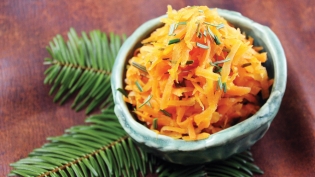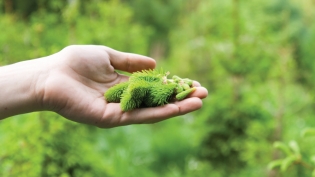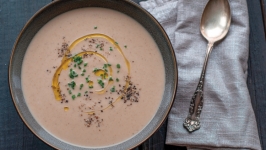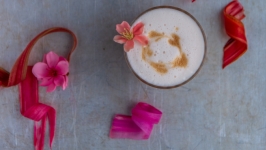Foraging for Flavours of the Forest
There’s a flush of electric green in the coastal forest as conifers send out their new spring shoots—and that means it’s prime time to forage.
"Most of the region’s fir, spruce and pine trees are edible," says Bill Jones, an Island chef, author and foraging expert, “but I especially love the Grand fir in spring, the new tips are soft and highly aromatic, and make a tea that will blow you away."
In his comprehensive book, The Deerholme Foraging Book (Touchwood), Jones shares recipes for wild foods of all kinds, including those using the needles and tender tips of the indigenous Douglas fir and Sitka spruce he collects in the forest around his farm in the Cowichan Valley.
Jones is just one of the chefs across the region who is incorporating conifers into their cooking. The citrusy flavour of this woodsy wild food is quickly becoming as Canadian as maple syrup and turning up in everything from coastal cocktails and pretty green pesto to crème brulée.
Jones says conifer tips add a hint of bitter grapefruit zest and a floral aroma to his Grand Fir Jelly, Spruce Infused Vodka, Oysters with Grand Fir Vinaigrette, and even a Grand Fir, Chocolate and Hazelnut Tart, which includes a cup of young fir needles infused into the cream for the ganache.
"There is something magical about the combination of grand fir and chocolate, though spruce and pine tips would be just as pleasing," he writes.
Spruce Experiments
Other Island chefs are experimenting with conifers, too. At OLO in Victoria, Spruce Cultured Cream is served alongside their Alder Smoked Salmon. In Qualicum Beach, north of Nanaimo, wild crafter and cook Mandolyn Jonasson adds citrusy fir and spruce tips to her creative menu at Island Sodaworks.
Laura Waters, of Snowdon House Gourmet in Saanich, uses the firs planted on her former tree farm to make vinegars and preserves, including her spicy Fir and Fire dipping sauce and Fir Essence for sodas and cocktails.
And it’s no surprise that Blue Spruce Ice Cream in Courtenay launched its line of artisanal ice cream with a signature Spruce Tip flavour—one that’s “tasty enough to give us our name.”
History
There’s a long history of cooking with conifers in Canada, from First Nations curing Pacific salmon with fresh fir tips to éclade de moules in Quebec, a traditional dish of mussels smoked in a vessel filled with burning pine needles.
Explorer Captain James Cook learned to brew spruce beer to help ward off scurvy, an inspiration for Tofino Brewing and its Spruce Tree Ale, conditioned with local Sitka Spruce tips. STUMP Coastal Forest Gin from Phillip’s Fermentorium in Victoria gets its distinctive rainforest flavours from island Grand Fir and juniper, while de Vine’s Vin Gin includes spruce among its traditional botanicals, and the frothy Cedar Sour cocktail at Tofino’s Wolf in the Fog is made with their own cedar-infused rye.
Forage and Cook
Cooking with conifers at home can be as easy as a trip to your own backyard. Collect the bright green fir and spruce tips when they first emerge in spring, just as they lose their papery husk, and are still tightly compressed and tender.
Pull a branch through your fingers, and you will find the “spiky spruce” and “friendly fir” descriptors useful for identification. Grand Fir needles are distinct, notched at the tip with white stripes along the back.
But make sure you know what you’re eating. Yew trees are highly toxic and may cause death if ingested, so it’s always best to forage with an expert.
Forage Workshop
Gather Victoria is a good place to start. Danielle Prohom Olson and Jennifer Aikman, the women behind Gather, take their inspiration from ancient traditions and seasonal celebrations, offering educational workshops and wild food feasts.
“Many of these are the same plants eaten by our ancestors,” says Prohom Olson. “Conifers are always great with cream and sugar, or you can mince needles and combine with salt or butter to rub on meat or salmon.”
You can also add the tender tips to spring salads or mince to fold into fresh goat cheese. Simply crushed and infused in honey, sugar syrups, oils, vinegars and spirits, coastal conifers add a wild edge to any dish.
Prohom Olson says the aromatic phytoncides that defend trees against bacteria, insects and fungi, are also medicinal for humans—the volatile oils emanating from spruce and fir can improve both your physical and emotional health.
Adds Aikman: “Gathering brings nature and magic back into everyday life.”















